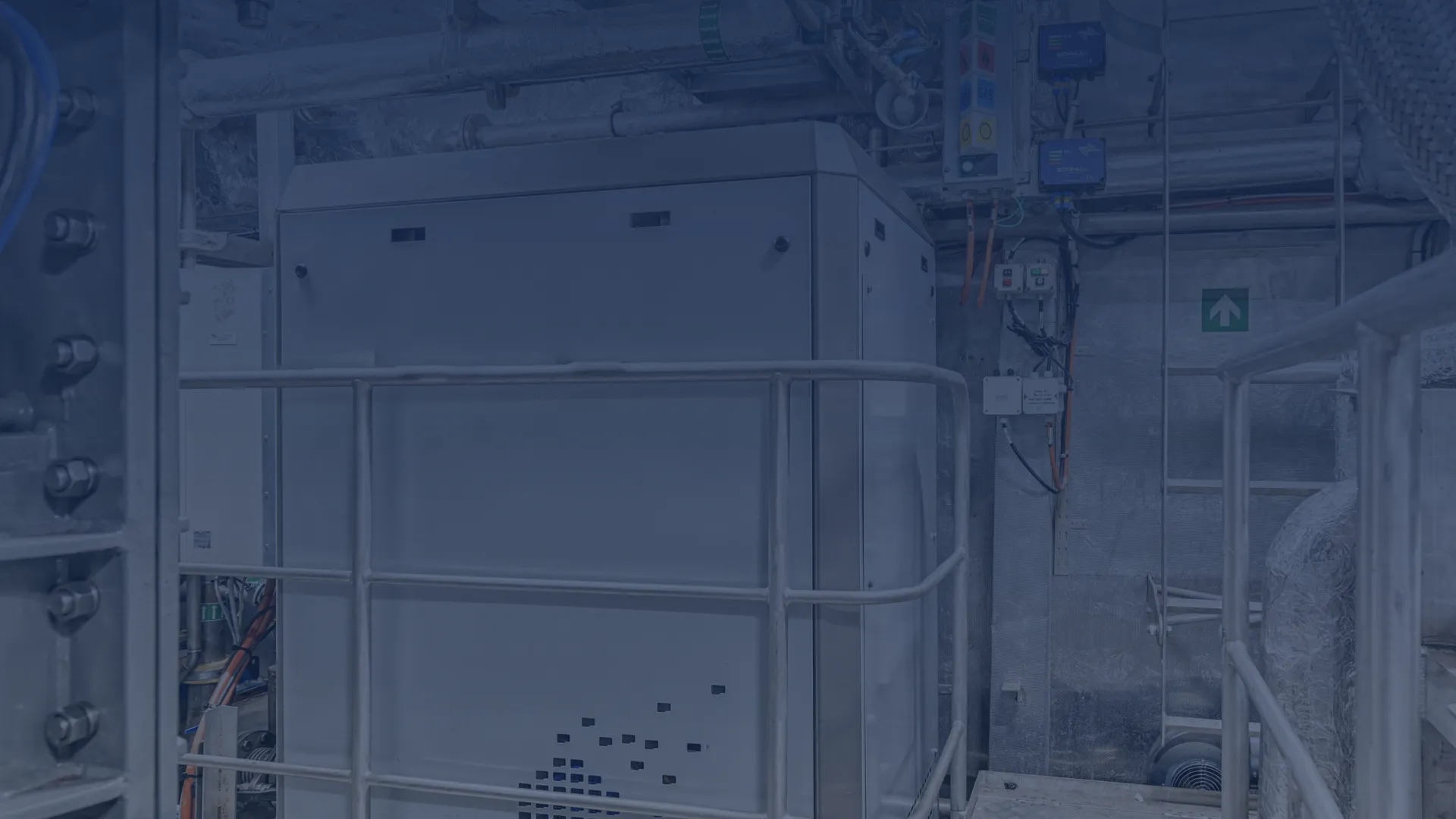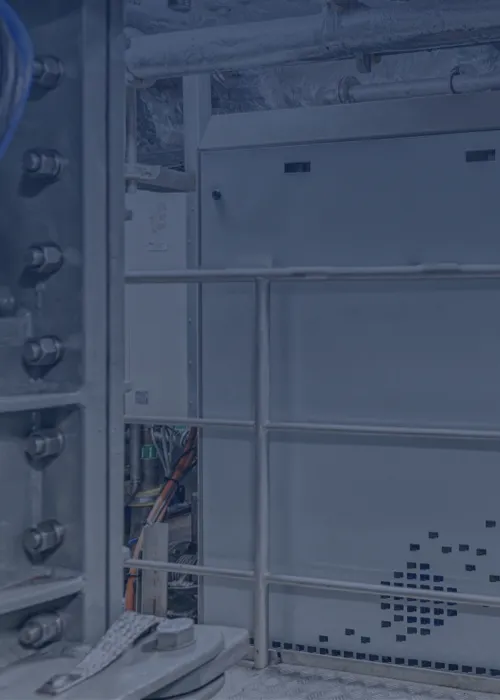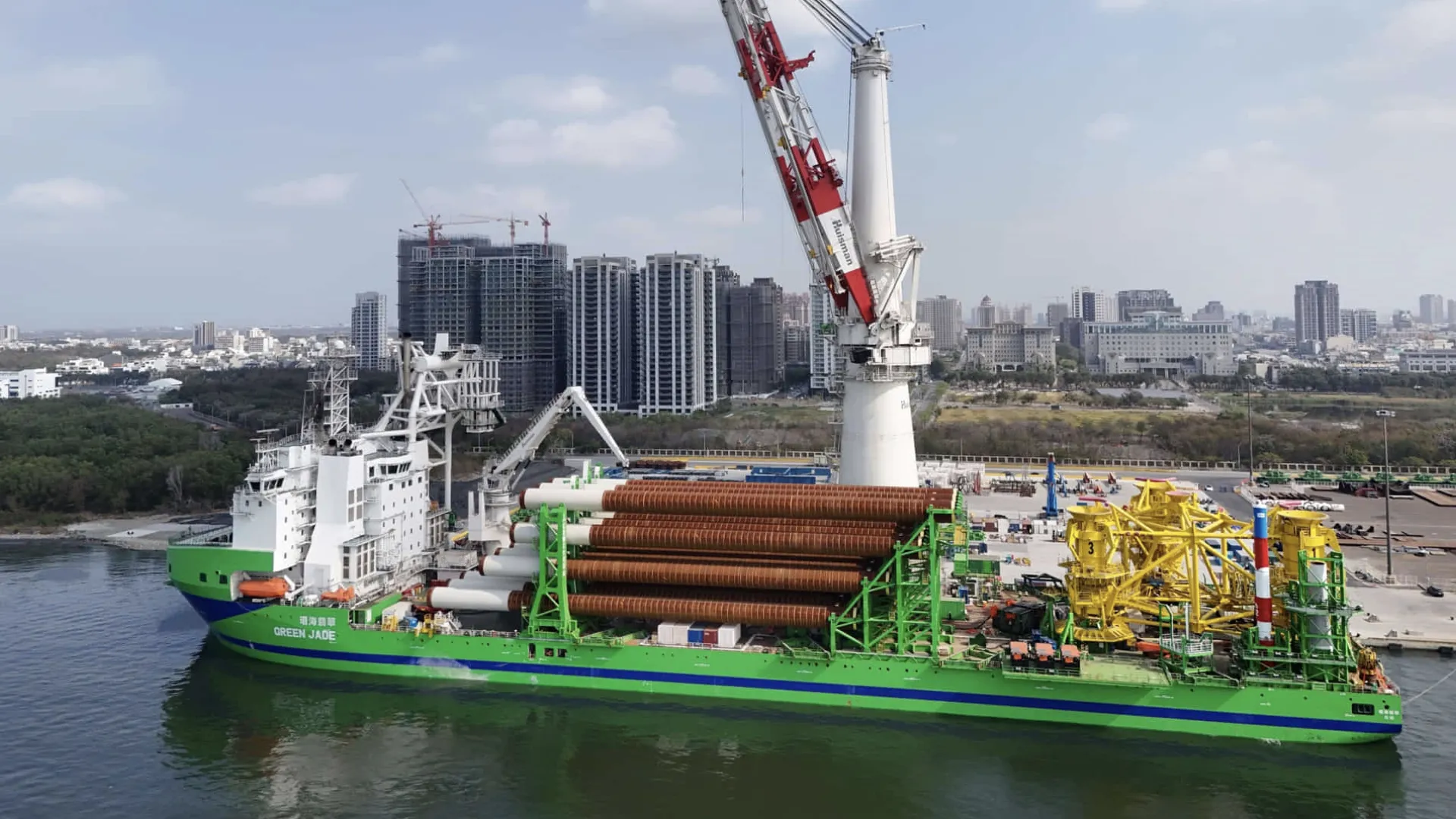
- English
- Nederlands

Waste Heat Recovery System

Waste heat is the heat released during the use of combustion engines and normally remains unused. In the maritime industry, harnessing waste heat can be particularly effective. This helps prevent energy waste and increases the sustainability of ships. More than half of the energy from fuel is lost through exhaust gases and engine cooling water. By reusing waste heat, ships become more energy-efficient and can more easily comply with stricter environmental regulations. Standards such as the Energy Efficiency Design Index (EEDI), the Energy Efficiency Existing Ship Index (EEXI), and the Carbon Intensity Indicator (CII) underscore the importance of heat recovery. Discover our partner’s waste heat recovery system (WHRS), specifically designed for ships. These innovative solutions, based on advanced Organic Rankine Cycle (ORC) technology, demonstrably enhance the energy efficiency of ships by 6 to 9%. The actual performance depends on factors such as engine power and the amount of available waste heat. A waste heat check can reveal how much energy you can save and help optimize your ship’s sustainability potential.
Waste Heat Recovery System
Discover our partner’s waste heat recovery system (WHRS), specifically designed for ships. These innovative solutions, based on advanced Organic Rankine Cycle (ORC) technology, demonstrably enhance the energy efficiency of ships by 6 to 9%.

Technology of Waste Heat Recovery
The Organic Rankine Cycle (ORC) is a physical process in which an organic working fluid continuously circulates to convert heat into kinetic energy. This advanced technology plays a crucial role in the effective recovery of waste heat. Thanks to this technique, the waste heat recovery system can not only capture heat from exhaust gases and jacket cooling water, but also convert residual steam and thermal oil into immediately available, usable electric power.
To better understand how the Organic Rankine Cycle (ORC) works, we illustrate how heat is extracted from jacket cooling water and exhaust gases. This process centers around five key components that form a closed cycle: the heat exchanger (evaporator), the expansion machine (turbine), the generator, the condenser, and the circulation pump. The ORC principle encompasses four essential phases: heat absorption, evaporation, expansion and energy generation, followed by condensation and repetition of the cycle.
In the following sections, we explore the ORC principle in greater detail and show how waste heat from ship engines and jacket cooling water can be converted into usable electricity phase by phase. This provides a clear overview of the applications and benefits of this innovative technology.
1. Heat Absorption
The ORC system effectively captures heat from both the exhaust gas channel and the jacket cooling water circuit. In the exhaust gas channel, heat is recovered by a heat exchanger (evaporator). This heat is transferred via a water circuit to the system, where it is combined with heat from the jacket cooling water, which is tapped directly from the cooling water circuit. The combined heat is then used to warm the working fluid – an organic refrigerant with a low boiling point – in the ORC cycle, causing it to evaporate in the evaporator.
2. Evaporation
The working fluid in the ORC is heated in the evaporator above its boiling point by the harnessed heat. This ensures that the fluid vaporizes, even at relatively low temperatures such as those typically found in waste heat sources like jacket cooling water.
3. Expansion and Energy Generation
After evaporation, the working medium is directed under high pressure to an expansion machine (turbine). The expansion machine converts the heat energy into mechanical energy. This mechanical energy is then used to drive a generator, which in turn produces electricity.
4. Condensation and Cycle Repetition
After passing through the expansion machine, the working medium loses its pressure and temperature, condensing back into a liquid state in the condenser. The condensate is then pumped back to the heat exchanger (evaporator) by a circulation pump, where it is reheated by the available waste heat. This closed cycle repeats continuously, generating a constant flow of electricity as long as sufficient waste heat is available on board your ship.
Electric Power and Modularity of Waste Heat Recovery Systems
The amount of electricity generated varies by ORC module. The smallest module, with a net output of 100 kW, is specifically designed for ships with relatively low engine power. The largest module is optimized for bigger ships with higher energy demands, delivering up to 200 kW of net power.
The modular design provides the flexibility to meet specific energy requirements. By combining multiple modules, the total amount of generated electricity can reach up to 1,000 kW of net power. This flexibility allows you to tailor the waste heat recovery system for both small and large vessels, maximizing efficiency and performance.
Properties of ORC Systems in Maritime Applications
The ORC-based waste heat recovery system complements your primary energy source and operates fully autonomously, without human intervention. Besides visual inspections, little maintenance is required. Moreover, these systems are relatively compact, making them easy to install in most engine rooms, especially in newbuild ships.
Thanks to the plug-and-play approach and the flexibility of the modules, they can be easily integrated into your ship’s engine room. This can occur, for example, in existing steam or thermal oil circuits, or directly in the exhaust gas channel.
Practical Applications of Waste Heat Recovery on Ships
Our experience with ORC technology began in 2016. Since then, our partner’s waste heat recovery installations have proven effective on various existing (retrofit) and new ships, ranging from a coupled inland vessel, a Rhine passenger ship, and multiple coastal vessels to a highly advanced wind turbine installation vessel equipped with eight waste heat recovery systems.

Waste Heat
Waste heat is the heat released during the use of combustion engines and normally remains unused. In the maritime industry, harnessing waste heat can be particularly effective. This helps prevent energy waste and increases the sustainability of ships. More than half of the energy from fuel is lost through exhaust gases and engine cooling water.
By reusing waste heat, ships become more energy-efficient and can more easily comply with stricter environmental regulations. Standards such as the Energy Efficiency Design Index (EEDI), the Energy Efficiency Existing Ship Index (EEXI), and the Carbon Intensity Indicator (CII) underscore the importance of heat recovery.
The actual performance of the waste heat recovery system depends on factors such as engine power and the amount of available waste heat. A waste heat check can reveal how much energy you can save and help optimize your ship’s sustainability potential.
Technology of Waste Heat Recovery
The Organic Rankine Cycle (ORC) is a physical process in which an organic working fluid continuously circulates to convert heat into kinetic energy. This advanced technology plays a crucial role in the effective recovery of waste heat. Thanks to this technique, the waste heat recovery system can not only capture heat from exhaust gases and jacket cooling water, but also convert residual steam and thermal oil into immediately available, usable electric power.
To better understand how the Organic Rankine Cycle (ORC) works, we illustrate how heat is extracted from jacket cooling water and exhaust gases. This process centers around five key components that form a closed cycle: the heat exchanger (evaporator), the expansion machine (turbine), the generator, the condenser, and the circulation pump. The ORC principle encompasses four essential phases: heat absorption, evaporation, expansion and energy generation, followed by condensation and repetition of the cycle.
In the following sections, we explore the ORC principle in greater detail and show how waste heat from ship engines and jacket cooling water can be converted into usable electricity phase by phase. This provides a clear overview of the applications and benefits of this innovative technology.
1. Heat Absorption
The ORC system effectively captures heat from both the exhaust gas channel and the jacket cooling water circuit. In the exhaust gas channel, heat is recovered by a heat exchanger (evaporator). This heat is transferred via a water circuit to the system, where it is combined with heat from the jacket cooling water, which is tapped directly from the cooling water circuit. The combined heat is then used to warm the working fluid – an organic refrigerant with a low boiling point – in the ORC cycle, causing it to evaporate in the evaporator.
2. Evaporation
The working fluid in the ORC is heated in the evaporator above its boiling point by the harnessed heat. This ensures that the fluid vaporizes, even at relatively low temperatures such as those typically found in waste heat sources like jacket cooling water.
3. Expansion and Energy Generation
After evaporation, the working medium is directed under high pressure to an expansion machine (turbine). The expansion machine converts the heat energy into mechanical energy. This mechanical energy is then used to drive a generator, which in turn produces electricity.
4. Condensation and Cycle Repetition
After passing through the expansion machine, the working medium loses its pressure and temperature, condensing back into a liquid state in the condenser. The condensate is then pumped back to the heat exchanger (evaporator) by a circulation pump, where it is reheated by the available waste heat. This closed cycle repeats continuously, generating a constant flow of electricity as long as sufficient waste heat is available on board your ship.
Electric Power and Modularity of Waste Heat Recovery Systems
The amount of electricity generated varies by ORC module. The smallest module, with a net output of 100 kW, is specifically designed for ships with relatively low engine power. The largest module is optimized for bigger ships with higher energy demands, delivering up to 200 kW of net power.
The modular design provides the flexibility to meet specific energy requirements. By combining multiple modules, the total amount of generated electricity can reach up to 1,000 kW of net power. This flexibility allows you to tailor the waste heat recovery system for both small and large vessels, maximizing efficiency and performance.
Properties of ORC Systems in Maritime Applications
The ORC-based waste heat recovery system complements your primary energy source and operates fully autonomously, without human intervention. Besides visual inspections, little maintenance is required. Moreover, these systems are relatively compact, making them easy to install in most engine rooms, especially in newbuild ships.
Thanks to the plug-and-play approach and the flexibility of the modules, they can be easily integrated into your ship’s engine room. This can occur, for example, in existing steam or thermal oil circuits, or directly in the exhaust gas channel.
Practical Applications of Waste Heat Recovery on Ships
Our experience with ORC technology began in 2016. Since then, our partner’s waste heat recovery installations have proven effective on various existing (retrofit) and new ships, ranging from a coupled inland vessel, a Rhine passenger ship, and multiple coastal vessels to a highly advanced wind turbine installation vessel equipped with eight waste heat recovery systems.

Frequently Asked Questions about ORC Systems and Waste Heat Recovery in the Maritime Sector
What are the advantages of an ORC system compared to a steam turbine?
ORC systems (Organic Rankine Cycle), as applied in waste heat recovery on ships, offer significant advantages compared to traditional steam turbines:
- Efficiency at lower temperatures: ORC systems can effectively generate electricity from waste heat sources, such as exhaust gases and engine cooling water, which operate at lower temperatures. This makes them ideal for applications where steam turbines would be less efficient.
- Safer due to lower pressure: ORC systems operate at significantly lower pressures than steam turbines, which not only increases safety but also reduces wear and tear on equipment.
- Flexibility and scalability: ORC technology can be easily adapted to different scales and energy needs, from small to large installations. Steam turbines, on the other hand, are often limited to large-scale, high-temperature applications.
- Lower maintenance costs: Due to the simpler design and lower operating pressure, ORC systems require less maintenance. This results in lower operating costs and a longer system lifespan.
- More environmentally friendly: ORC systems use organic working fluids that are less environmentally harmful than the high-temperature steam in traditional turbines, contributing to a smaller ecological footprint.
For which types of ships are ORC-based waste heat recovery installations suitable?
ORC-based waste heat recovery installations are designed with diversity and flexibility in mind to serve a wide range of ship types across different sectors. Whether it’s maritime, coastal, cruise, fast ferries, offshore, inland shipping, dredging, fishing, navy, or mega yacht construction, these installations are suitable for both new and existing ships.
The strength of this technology lies in its compatibility and future-proofing with various combustion engines and fuels. Whether it’s biofuels, LNG/CNG, GTL, methanol, MGO, dual fuel, or HFO, ORC-based installations offer flexibility in fuel choice and optimize your ship’s energy efficiency system.
To determine the suitability of this technology for your specific ship, several factors are important, such as the sailing profile, operational sailing hours, and installed propulsion power.
Can an ORC system be integrated with other energy efficiency and emission-reducing technologies on board?
Yes, the ORC-based waste heat recovery system can be seamlessly combined with other energy efficiency and emission-reducing technologies on board.
For example, the electricity generated by the ORC system can be used to power the compressor of an air lubrication system, effectively covering the energy demand for injecting air bubbles under the ship’s hull.
Additionally, the heat exchanger (evaporator) of the ORC system can be integrated with a Selective Catalytic Reduction (SCR) catalyst. This integration simplifies the placement of the heat exchanger and optimizes space utilization in the engine room.
How does the use of waste heat recovery contribute to improving my ESG reporting?
The use of waste heat recovery contributes to your Environmental, Social, and Governance (ESG) reporting in several ways.
By improving your ship’s fuel efficiency and reducing CO2 emissions, you significantly reduce your ecological footprint. This is an essential aspect of ESG reporting, demonstrating not only compliance with current regulations but also your organization’s active commitment to sustainable and responsible business practices.
Implementing waste heat recovery can improve your ESG score and strengthen your position as a sustainable player within the maritime sector.
How else can I contribute to complying with environmental regulations besides using waste heat recovery?
In addition to applying waste heat recovery, there are various other ways to contribute to complying with environmental regulations, such as the Energy Efficiency Existing Ship Index (EEXI) and the Carbon Intensity Indicator (CII).
You can, for example, integrate advanced technologies such as Energy Saving Devices (ESDs) and wind-assisted propulsion systems to further optimize your ship’s fuel efficiency.
Am I eligible for a subsidy on an ORC-based waste heat recovery system?
Yes, you may be eligible for a subsidy on an ORC-based waste heat recovery system. For example, you can benefit from tax advantages through the Energy Investment Allowance (EIA). The system utilizes the Organic Rankine Cycle (ORC) principle, which is listed on the Environmental and Energy List.